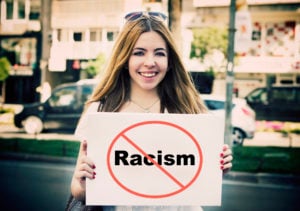
Source: Getty Images
I get to participate in some pretty awesome conversations as part of my work.
One of my favorites, though, is when I get to talk to college students about what makes for a mind-blowing, talk-about-it-for-years party.
I ask the question, and students just start shouting out things like:
“The perfect DJ!” “Everybody’s dancing!” “Booze.” “Drugs.” “Some non-alcoholic drinks/mixers.” “Sexy ladies!” “Sexier men!” “No drama.” “Food.” “Sex!” “Everybody’s gettin’ lucky!” “SEX!”
Let’s be honest: By and large, one of the only things that college students love more than partying and sex is talking about partying and sex.
What’s phenomenal about this conversation, though, is the opportunity it provides to extend the dialogue beyond beer bongs, booty shaking, and backroom hookups. It provides an entry into a conversation about positive sexuality and sexual violence prevention.
With rare exceptions, no one who is throwing a party spends the time, energy, and money so that people will get assaulted. Yet there is a clear connection between college party culture and sexual violence.
After all, 74% of perpetrators of sexual violence on college campuses were under the influence of alcohol when they committed the assault, and 55% of survivors of sexual violence on campuses were under the influence of alcohol when assaulted.
Unfortunately, on college campuses, this dialogue translates too often into shaming and blaming of survivors for their decisions to drink or approaches to “prevention” that place the onus on potential “victims” to keep themselves from getting raped.
And to mitigate the risk, most colleges simply take a punitive approach (with varying levels of alcohol education – which is fantastic – thrown in) to alcohol on campus.
But it doesn’t have to be that way.
In fact, we need to see college partying and the terrifying link to sexual violence as an opening to a different kind of conversation about the social time our young people are spending on college campuses or anywhere for that matter.
Shifting to Sex Positivity
Most of the college students that I work with have never heard of the concept of sex positivity. I know I sure hadn’t when I started college.
But in any conversation about sex with young people, when I introduce the definition I work from, the tone shifts considerably, no matter how we were discussing sex before.
Here’s the definition I’m working from:
Sex positivity refers to positive, affirming, consensual sexual relationships, characterized by open, honest communication and attention to the needs and desires of oneself and one’s partner(s).
Sounds amazing, right?
Well, most of the young people I get to work with on college campuses all over the US think so, too!
So when I tell them that it’s possible to make simple changes to your average party environment that make it more sex positive, they are pumped!
But every now and then, I have the skeptical workshop participant (usually a dude, but not always) who says something to the effect of “It sounds like one giant cock-block to me.”
But without fail, whenever this sentiment is expressed, I don’t even have to respond!
Last time this happened, a young woman explained, “Unless you’re looking to rape somebody, this sounds like the opposite of a cock block. Nothing sounds hotter than dancing with someone at a party only to learn that they are a great kisser who asks first!”
Undoubtedly, we have to spend some time and energy thinking about the worst case scenario, understanding and exposing predators, and taking preventative precautions.
But sexual violence prevention, particularly as it relates to parties, can (and must) be so much more than that!
What Does Sex-Positive Partying Look Like?
Once introduced to the idea of sex positivity in the context of partying, students come up with all sorts of amazing ideas for making their parties more sex-positive and, by extension, preventative of sexual violence.
“Have multiple rooms, one that’s more geared toward talking and getting to know one another with low music, one that’s for drinking and mixing up your beverage, and one that’s for dancing where the music is a bit louder and the lighting is darker.”
“Have a bar tender to help control the flow of alcohol and ensure no one gets too shit faced.”
“Put out condoms in a bowl by the drinks or snacks so that people are thinking ahead about healthy sex.”
“In addition to drinking games, have games that get people talking and laughing together like Cards Against Humanity.”
“Have people demonstrate a creative way to ask for consent before they can come in the door.”
“Rather than party themes that encourage objectification like ‘Pimps & Hoes’ (a popular theme at a lot of college parties all over the U.S.), get more creative. We did one that was 90s cartoon themed that was hilarious!”
Every one of those ideas – every single one – came from college students.
My point here is that when given the knowledge and tools to see partying through a new lens, students are more than excited to figure out how to construct different types of social spaces.
Because the vast, vast majority of us want our social spaces to be safe.
The vast, vast majority of us want our social spaces to be fun.
The vast, vast majority of us want our social spaces to be ones where every person can enjoy herself or himself without fear of what happens next.
And the vast, vast majority of us want our social spaces to produce relationships, sexual or otherwise, that are positive and fulfilling.
So when young people are given permission to create these kinds of social spaces, they take them back from the tiny few who would construct spaces of predation and violence.
They just simply need the tools.
Research & Sex Positive Parties
The beauty of this approach to party culture, though, is that it’s not just supposition and conjecture.
There is research to support the idea that simple changes can be made to your average party environment to make it more preventative of sexual violence.
In their article “Fraternities and Collegiate Rape Culture: Why are Some Fraternities More Dangerous Places for Women?” A. Ayers Boswell and Joan Z. Spade explore what aspects of party environments can make a party higher or lower risk for sexual violence perpetration during or after the party.
Now, I know some of you will say “But that’s only with fraternities!” but let’s be honest : Most of the fraternity parties I’ve gone to don’t look that different from the average rager at my zero Greek life undergraduate institution.
So let’s take a look at what they found.
For simplicity’s sake, I’ve boiled down their findings into characteristics that make a party higher risk or lower risk for sexual violence.
Gender Dynamics
Characteristics of higher-risk parties:
- Skewed gender ratios
- Gender-segregated socializing where the few conversations happening between men and women were flirtatious or sexual in nature
- Conversations are more dominated by men
Characteristics of lower-risk parties:
- More balanced gender ratios
- Multi-gendered interactions and conversations are common where the floor is shared equally
Ambiance
Characteristics of higher-risk parties:
- Less attention to cleanliness; if there is even a women’s restroom designated, it is poorly maintained/cleaned
- Few places to sit, making conversation more difficult to sustain
- Music is so loud that conversation is difficult if not impossible
Characteristics of lower-risk parties:
- Cleanliness is clearly considered by hosts; restrooms, particularly a women’s restroom, well maintained
- Varied options for sitting, standing, dancing, offering many ways to socialize and converse
- Music is at a volume that makes conversation possible; if there is a loud dance area, there are also rooms/spaces for conversing
Behavior
Characteristics of higher-risk parties:
- Drinking is primarily binge-oriented, meaning larger amounts are consumed in less time
- Horse play is common and tolerated, particularly among men, and fights were recorded
- Dancing was more sexual in nature, meaning close in proximity and primarily between couples Jokes or language that degrades women was more common and tolerated
Characteristics of lower-risk parties:
- Drinking was more casual, and consumption was spread out over longer periods of time
- Dancing was mixed, with close couple dancing interspersed with group dancing and social dancing
- Degrading or oppressive language was challenged
Obviously it is not possible to control for every one of these variables. At most parties, at least one person is going to get wasted, and it can be tough to control for oppressive language or horse play.
But there’s a prevailing message behind the research.
Parties where people can interact, converse, and socialize more readily and in more positive ways create significantly lower-risk for sexual violence.
Why is that?
Well, conversation humanizes another person. Laughing and talking in groups humanizes the people around you. And the root of sexual violence is dehumanization, putting one’s own desires above that of another human being.
—
Thus, if we can encourage parties where people still go out and have an amazing time but where attendees are having more humanizing interactions, we can help reduce sexual violence.
Is this going to solve the problem of sexual violence? Surely not. But it goes a long way in shifting culture and climate that supports sexual violence.
And that can go a long way in reducing the prevalence of sexual violence while encouraging more healthy, fulfilling sexual relation.
Want to discuss this further? Login to our online forum and start a post! If you’re not already registered as a forum user, please register first here.
Jamie Utt is a Contributing Writer at Everyday Feminism. Jamie is a diversity and inclusion consultant and sexual violence prevention educator based in Minneapolis, MN. He lives with his loving partner and his funtastic dog. He blogs weekly at Change from Within. Learn more about his work at his website here and follow him on Twitter @utt_jamie. Read his articles here and book him for speaking engagements here.
Search our 3000+ articles!
Read our articles about:
Our online racial justice training
Used by hundreds of universities, non-profits, and businesses.
Click to learn more




















